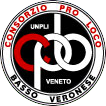GEOGRAPHY
The town of Terrazzo, with its surface of 20.53 km² is located at an average altitude of 12 m above sea level. It is 50 km away from Verona and it is situated at the southern extremity of its territory, on its borders with the province of Padova, on the left bank of the river Adige. Its two fractions are Begosso and Nichesola. It borders Villa Bartolomea, Castagnaro, Bevilacqua, Boschi Sant’Anna, Legnago (under the province of Verona); Castelbaldo, Merlara, Urbana (under the province of Padova) and Badia Polesine (under the province of Rovigo).
ETYMOLOGY
The name of the town is likely to come from the Latin “turris”, as chronicled by the town emblem, which displays a tower. The portrayed building references the castellated tower that, with its swallowtail battlements, dates back to the 1000s and is located in a large developed area right next to the borders of Merlara.
HISTORY
Even though the origins of Terrazzo are probably Roman, the name of the town appears for the first time in a papal bull by Eugene III in 1145. The ancient tower is most certainly one of the oldest buildings of the town, surrounded by what remains of the fortress built around the year 1000. During the thirteenth century, the walls of this stronghold were twice put to the test by the sieges of the Veronese podestà Ruberto de Pii, but the valiant and tireless resistance of the troops led by Gracco da Verona ensured the safety of the fortress.
Due to its strategic proximity to Bevilacqua, Legnago, Montagnana and some local cloisters, the town of Terrazzo was for a long time domain of several rich families such as: Brizzi, Nani Mocenigo, Cucina Ferri, Riva, Nogarola, Degani, Marchesi Bonfà and Dondi dell’Orologio.
During the 1500s Terrazzo was involved in the conflicts between Venice and the cities affiliated to the Lega di Cambrai, remaining loyal to La Serenissima Repubblica di Venezia. In 1630 the black plague scourged the lands around Verona and reached Terrazzo as well, even though the town wasn’t hit as hard as other areas of the Province. After the fall of La Serenissima, these lands were contended by France and Austria, but with the Restoration, in 1815, Terrazzo became part of the fifth district of Legnago, which belonged to the province of Verona, under the Regno Lombardo-Veneto. The situation remained unchanged until 1866 when the town of Terrazzo was assigned to the province of Verona by a Royal Decree, since Veneto became part of the Kingdom of Italy.
In spite of the hardships and the heavy seasonal emigration, the people of Terrazzo focused on agriculture and managed to carry on. Only in the 1960s the town would finally reach a reasonable wealth.
ART
Definitely worth seeing are the ancient medieval tower that gave Terrazzo its name, Villa Fascinato and its oratory, Villa Adele Brizzi, Villa Ca’ Nogarola (15th-16th century), Villa Cucina Ferri (16th century), Villa Degani-Ghezzo Tardivo, Villa Tomelleri-Degani, Villa Venturi-Carazzato (17th century). Also noteworthy are Palazzo dei Conti Pelà, Corte Bottagisio – Villa Nani Mocenigo and Corte Baldiserotto (15th – 17th century). Some refined and elegant residences are lined up on the banks of the river that cuts through the town. Remarkable are the parish of Terrazzo, dedicated to San Paolo, the parish of Begosso, dedicated to San Lorenzo and the small church of Nichesola, with its frescos, dedicated to San Celestino. There are several wayside shrines on the banks of the river Adige.
ECONOMY
Terrazzo is renowned as the town of the apple due to the qualified production of this sweet and tasty fruit. The lands designated to apple farming constitute one of the main outputs of the town. Beyond 30 different varieties of this fruit are produced, yielding around 14.000 tons of apples every year.
The economy of Terrazzo, thanks to its agriculture, developed around the production and transportation of distilled beverages. Craftsmanship also contributes to the town’s economy.
